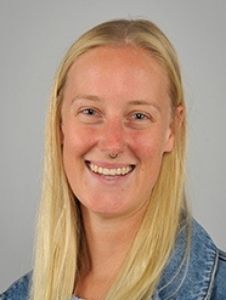
$1.64 million for Otago in HRC funding rounds.
Vanilla, Golden Strawberry, Peaches and Cream, and Green Apple. These sound like tasty, harmless treats. But what about when they are in a vape pen rather than a dessert bowl?
Dr Graham Eyres, of the Department of Food Science, along with co-investigator Associate Professor Pat Silcock, have received a $150,000 Explorer Grant from the Health Research Council (HRC) to develop novel testing methods that will enable regulatory bodies in New Zealand to evaluate the unknown safety and long-term health effects of flavours commonly added to the liquids used in e-cigarettes.
The group's project is one of nine from the University of Otago to be awarded a total of just under $1.65 million in the recently announced Explorer and Emerging Researcher grants.
Dr Eyres, who has significant experience researching flavours used in the food industry, says the flavourings added to the liquids used with e-cigarettes or vaping devices are currently regulated under the Food Standards Code. The problem is, he says, that the code only covers the safety of ingesting these flavourings in food; it does not consider the use of these flavourings when inhaled.
“E-cigarettes heat a liquid into an aerosol or vapour cloud that is inhaled by the user, typically delivering doses of nicotine to the lungs,” Dr Eyres says.
“In New Zealand, the range of flavourings added to the liquids in e-cigarettes have not been characterised or quantified. This is concerning because some of the volatile organic compounds generated during vaporisation may be directly harmful if inhaled at high concentrations or may degrade to form harmful compounds.”
Recent international research has shown that 74 per cent of commercial liquids in e-cigarettes contained diacetyl, with more than 40 per cent at concentrations higher than the recommended safety limits. The proportion of New Zealand e-cigarettes that contain diacetyl is unknown.
“With this Explorer Grant, we will use methods developed in food and environmental science and redesign them to better understand what compounds are in these e-cigarette liquids and how these compounds are distributed within different sized aerosol droplets. Armed with this knowledge, we can then work with toxicologists and health professionals to determine what the level of risk is from these compounds and hopefully provide regulators with the evidence they need to develop specifications and standards on e-cigarettes,” Dr Eyres says.
Meanwhile, Professor George Dias's project, for which he and co-investigators Associate Professor Vincent Bennani and Dr Niranjan Ramesh have been awarded a $150,000 Explorer Grant, is one which will literally have people smiling.
Recognising the surging costs of dental care, resulting in almost three-quarters of New Zealanders avoiding a trip to the dentist, Professor Dias says his team aims to develop a bioactive smart toothpaste that will provide an affordable clinical grade formulation to mitigate oral infections and ensure implant longevity.
“According to the New Zealand Ministry of Health, 40,000 children under the age of 15, and 270,000 adults have had one or more teeth removed due to decay, abscess, infection, or gum diseases in 2018 and 2019.
“One in three adults in New Zealand had untreated coronal decay and one in ten had root decay, with the Māori and Pasifika communities presenting the poorest oral health outcomes amongst all the communities in New Zealand,” Professor Dias says.
“These statistics show that there is an inherent and immediate need to improve the oral health outcomes among all ethnic groups in the country by developing smart, affordable and clinically effective solutions that are easily accessible to the public via supermarkets and pharmacies. This will in-turn also reduce the economic burden of management of dental care on the New Zealand healthcare systems.”
There are about 5.5 million dental implants placed and restored every year globally and about 11 per cent of those will fail within 10 to 15 years, largely due to infections and inflammation.
“While the dental problems have evolved with time and changing lifestyles present bigger challenges in terms of maintenance of oral hygiene, the longevity of implants, and restorations, the solutions to such problems such as toothpaste haven't sufficiently evolved and are still largely focused on plaque removal, desensitising, and whitening, barring a few exceptions,” he says.
The smart toothpaste proposed in the study will be made from a modified bio-ceramic material that mimics the natural inorganic makeup of the teeth and will help restore damage to the tooth surface - due to inflammation, infection, harsh foods, or trauma - and provide the desired polishing and plaque removal effects for whiter teeth.
“The result of this carefully selected combination is a highly functionalised toothpaste which does more than its conventional counterparts, will help maintain the dental restorations and implants by allowing them to integrate better and greatly reducing the chances of failure.
“One of the most significant benefits of the proposed smart toothpaste is that it will significantly reduce the need for retreatment or emergency appointments to the dentist to restore an implant that has failed prematurely, or even worse, is causing an adverse reaction.”
Deputy Vice-Chancellor (Research and Enterprise) Professor Richard Blaikie says Otago is grateful for HRC's ongoing support which enables the University to continue its world-leading research.
“We are delighted with our researchers' success in this funding round, which is particularly important for the future role of health research in improving the lives and wellbeing of New Zealanders.
“The careers of the next generation of research leaders will be accelerated through the Emerging Researcher grants, while feasibility and early data collection for important long-term studies will be enabled through the Explorer grants.”
Emerging Researcher Grants
Dr Claire Henry, University of Otago, Wellington

Dr Claire Henry
Extracellular Vesicles as prognostic markers for Endometrial Cancer
36 months, $ 249,374.64
Endometrial cancer is the most common gynaecological cancer in New Zealand, and incidence rates are rising, particularly in younger women. Research is needed to meet ongoing disparities in health outcomes and to timely address the changing population effected by this disease. A higher number of women with endometrial cancer, or pre-lesions, are being treated with the Mirena intra uterine device when unable to have surgery or want fertility sparing options. Around 40% of tumours will not response to this type of treatment, and there is a significant gap in the literature around why this is, and if we can predict the type of response. Our project will be the first to investigate whether packaged information in the form of RNA can be measured in blood, in the attempt to provide a predictive and non-invasive test.
Dr Rachelle Martin, University of Otago, Wellington

Dr Rachelle Martin
Flourishing together: including tāngata whaikaha in health policy development
36 months, $249,009.00
To positively impact on the social determinants of health, tāngata whaikaha (disabled people) need to contribute to policy planning and programme development. However, they report not being able to engage in consultation processes meaningfully. Additionally, their advocacy recommendations may not be articulated in a way that policy planners can easily use. This gap contributes to inequities in health outcomes. Co-production methods can improve the responsiveness of health-related policies. We will partner with tāngata whaikaha to co-produce policy advice around kāinga (housing) - developing a nuanced understanding of the contexts in which disabled people can access and maintain kāinga in a way that meet their needs and aspirations. Alongside, we will develop innovative methods and tools that can be used in other policy planning spaces. The tools developed will empower and enable tāngata whaikaha to create and articulate knowledge that better addresses equitable policy and programme development within Aotearoa, New Zealand.
Dr Narun Pornpattananangkul, University of Otago

Dr Narun Pornpattananangkul
Multimodel Neuroimaging Biomarker for Cognitive Deficits in ADHD
36 months, $249,999.78
Around 5% of NZ children have Attention deficit/hyperactivity disorder (ADHD). ADHD is strongly linked with cognitive deficits, making the children at risk for lower educational and employment attainment later in life. Improving our ability to detect and trace ADHD-related cognitive deficits will enable early intervention and evaluation of treatment progress. Yet, our NZ population alone is too small to allow for optimal methods to identify key brain processes underlying ADHD. Fortunately, 'big data' including very large numbers of detailed brain images available through our collaborators in the US, and novel machine learning that enables analysis of big data are a specialty of our research program. Combined with an expert in ADHD, brain imaging experts, ready access to the big data, and a recent pilot approach that has proven successful, the proposed study provides an optimal opportunity to identify the key brain processes underlying ADHD at the earliest developmental stage possible.
Explorer Grants
Dr Sarah Appleby, University of Otago, Christchurch

Dr Sarah Appleby
The role of circulating bacterial DNA in cardiovascular disease
24 months, $ 150,000.00
The trillions of bacteria that live in our gut (called the gut microbiome) have an important role in the normal functioning of the healthy gut, but they can also modify or influence biological functions, which can result in disease. An intact gut barrier limits their escape and ability to do this; but this barrier can be breached, a phenomenon termed 'leaky gut'. Recent evidence has found that this barrier may be penetrated prior to a heart attack (a leading cause of death in New Zealand). Bacteria can then travel through the barrier, enter our bloodstream, and trigger an immune response which can potentially cause subsequent cardiovascular events. Our project will use cutting-edge DNA sequencing technology to identify DNA from gut bacteria in the blood of patients that have had a heart attack. This work could identify novel therapeutic targets that will reduce the morbidity and mortality from cardiovascular disease.
Associate Professor Yusuf Cakmak, University of Otago

Associate Professor Yusuf Cakmak
Auricular stimulation to improve cough sensitivity after stroke
24 months, $ 150,000.00
Neurological disease, such as stroke, has a devastating effect on sensation in the throat and the cough reflex. Without the ability to detect food or fluid from entering the lungs and eject it with a cough, stroke patients are at a high risk of developing a chest infection. Chest infection is associated with prolonged hospitalisation, high death rate, and significant cost to the healthcare system. There are currently limited rehabilitation options available. Interestingly, probing the ear canal during a medical examination or having impacted ear wax can elicit coughing. We propose to develop a protocol and explore the effect of using light electrical stimulation of the nerves within the outer ear to improve cough sensitivity after stroke. Using a wearable device to stimulate the external ear has the potential of providing a portable, safe, non-invasive, and low-cost treatment for improving the cough reflex and boosting airway protection.
Professor George Dias, University of Otago

Professor George Dias
A Smart Toothpaste for the Twenty First Century
24 months, $ 150,000.00
Management of dental disorders such as decay, gum disease, and implant failures are a major economic burden to NZ. The Māori community present the poorest oral health outcomes amongst all communities in the country. The surging costs of dental restorations are proving increasingly unaffordable with almost three-quarters of New Zealanders avoiding going to the dentist due to cost. While dental procedures have evolved with time, dental products such as toothpaste still resolve only a narrow spectrum of issues such as plaque, caries, and sensitivity. A novel bioactive smart toothpaste will be prepared using bioceramics and a natural anti-inflammatory and antimicrobial agent will provide an inexpensive clinical grade formulation to mitigate oral infections and ensure implant longevity while also offering the traditional benefits of plaque removal and whiter teeth. The affordable and easily accessible smart toothpaste will significantly improve the oral health of all communities in NZ and across the world.
Dr Graham Eyres, University of Otago

Dr Graham Eyres
Designing better methodologies to enable robust risk assessment of vaping
24 months, $ 150,000.00
'Vaping' or e-cigarettes have been promoted as a tool to support smoking cessation to improve public health, with their use growing at exponential rates. However, the toxicity and long-term health effects of compounds generated during vaping are not known. There is an urgent need to develop methods to evaluate the safety of vaping products. This project will develop novel analytical methods and testing protocols to understand the chemical composition of the aerosol vapour generated by e-cigarette devices. By separating and analysing each fraction of e-cigarette vapour, we will provide new opportunities to improve understanding of the chemical composition and the delivery of these compounds to the lungs during vape inhalation. Without this methodology, it will be impossible to obtain essential knowledge to inform regulators with evidence to enable appropriate policies, including industry regulation to ensure that long-term health impacts are minimised.
Dr Martin Fronius, University of Otago

Dr Martin Fronius
Contribution of ENaC in Covid-19
24 months, $ 150,000.00
Infections with SARS-CoV-2 virus cause COVID-19 and can lead to severe respiratory complications. This application aims to assess the contribution of the epithelial Na+ channel (ENaC) to these complications. The rationale derives from recent evidence that the SARS-CoV-2 virus has evolved a new peptide sequence in its spike protein known to be targeted by host proteases. Intriguingly, this sequence exactly matches a peptide sequence only found in the a ENaC subunit, where cleavage by proteases is essential for activating the channel.
Professor Tim Woodfield, University of Otago, Christchurch

Professor Tim Woodfield
Personalised 3D Tissue Models: Reducing Health Inequities in Cartilage Therapies
24 months, $ 150,000.00
Osteoarthritis (OA) affects over 10% of New Zealander's and is commonly treated using metallic prostheses. With innovative technologies, surgical interventions have started to transform from total joint replacements to implanting “bioimplants” using patients' own cells combined with biomaterials. However, these bioimplant platforms are not consistently successful due to large donor variability. A key issue is that these new bioimplants are often tested in near ideal surgical conditions and are thus not optimised for patients suffering from end stage OA. As Māori patients are known to present with more severe OA, they today have the worse postoperative outcomes. In this study, we thus aim to study differences in cellular performance between Māori and non-Māori patients and subsequently develop a personalised 3Dtissue model to optimise bioimplants also in diseased environments. Elucidating donor-to-donor variability and optimising bioimplants will aid in eliminating ethnic inequities to better meet the prevalent clinical issue of joint damage.